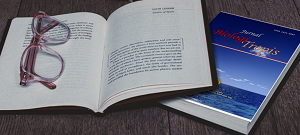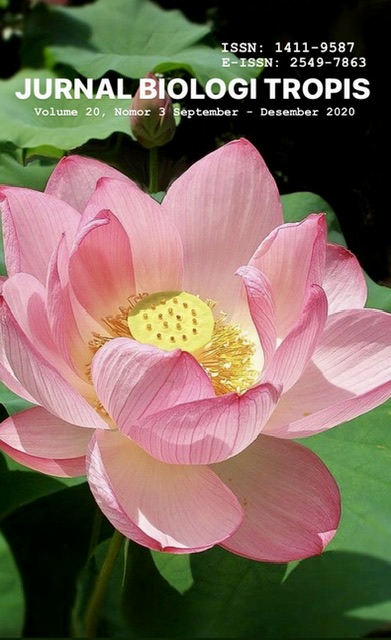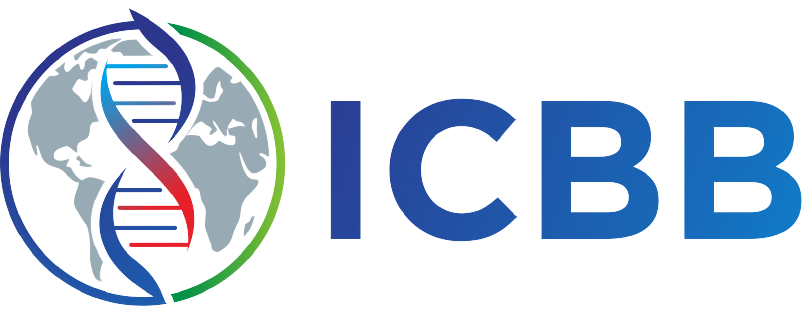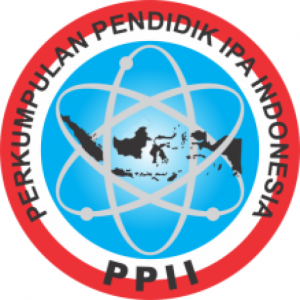
Most read articles by the same author(s)
- Wahida Hajrin, Windah Anugrah Subaidah, Yohanes Juliantoni, Dyke Gita Wirasisya, Application of Simplex Lattice Design Method on The Optimisation of Deodorant Roll-on Formula of Ashitaba (Angelica keiskei) , Jurnal Biologi Tropis: Vol. 21 No. 2 (2021): Mei - Agustus
- Trasna Arman Jani, Aliefman Hakim, Yohanes Juliantoni, Formulation and Evaluation of Antioxidant Peel-Off Face Mask Containing Red Dragon Fruit Rind Extract (Hylocereus polyrhizus Haw.) , Jurnal Biologi Tropis: Vol. 20 No. 3 (2020): September - Desember
- Dyke Gita Wirasisya, Nisa Isneni Hanifa, Wahida Hajrin, Ethnobotanical Study of Medicinal Plants Used to Treat Degenerative Disease in East Lombok , Jurnal Biologi Tropis: Vol. 20 No. 3 (2020): September - Desember
- Mariama Fitriana, Wahida Hajrin, Windah Anugrah Subaidah, Sucilawaty Ridwan, Eskarani Tri Pratiwi, Uji Antiinflamasi Ekstrak Etanol Ashitaba (Angelica keiskei) Secara In Vitro , Jurnal Biologi Tropis: Vol. 24 No. 2b (2024): Special Issue
- Handa Muliasari, Nisa Isneni Hanifa, Wahida Hajrin, Mahacita Andanalusia, Agriana Rosmalina Hidayati, Determination of Antioxidants by DPPH Scavenging Activity of Ashitaba Herb (Angelica keiskei) Methanol Extract , Jurnal Biologi Tropis: Vol. 23 No. 4 (2023): October - December
- Weny Syafitri Utari, Eskarani Tri Pratiwi, Windah Anugrah Subaidah, Sucilawaty Ridwan, Optimization of Cream Formula Extract Sargassum Crassifolium Using Varied Concentrations of Glyceryl Monostearate and Triethanolamine Emulgators With The Simplex Lattice Design Method , Jurnal Biologi Tropis: Vol. 25 No. 3 (2025): Juli-September
- Acyuta Pramesthi Asmara Sayidina Syahputri, Wahida Hajrin, Windah Anugrah Subaidah, Optimization of Lip Balm Formula From Buni Fruit Extract (Antidesma bunius L. Spreng) with A Combination of Beeswax Lanolin , Jurnal Biologi Tropis: Vol. 25 No. 3 (2025): Juli-September
- Ni Made Ayu Dinda Permatasari, Handa Muliasari, Nisa Isneni Hanifa, Agriana Rosmalina Hidayati, Dedianto Hidajat, Wahida Hajrin, Adila Rizkika, Anti-Radical Activity Test of Fractions from Ashitaba Herbs (Angelica keiskei) , Jurnal Biologi Tropis: Vol. 24 No. 4 (2024): Oktober - Desember
- Yunita Yunita, Agriana Rosmalina Hidayati, Wahida Hajrin, Anifungi Activity Test of Ethanoled Extract of Cashew Gua Leaves (Anacardium occidentale) Against Candida albicans , Jurnal Biologi Tropis: Vol. 24 No. 4 (2024): Oktober - Desember
- Agriana Rosmalina Hidayati, Dedianto Hidajat, Wahida Hajrin, Nisa Isneni Hanifa, Mahacita Andanalusia, Regina Tria Hidayati, Alpa Alfi Rizki, Prianggawe Prianggawe, Muhammad Rafi Bintang Ramadhan, Adila Rizkika, Formulation and Evaluation of the Physical Properties of Anti-Acne Cream Containing Methanol Extract of Ashitaba Herb (Angelica keiskei) , Jurnal Biologi Tropis: Vol. 25 No. 4a (2025): Special Issue
Similar Articles
- Ni Luh Putu Agustini, Desak Putu Risky Vidika Apriyanthi, Ayu Saka Laksmita, Potency of Kaliasem Bark (Syzygium polychephalum) Extract as Antibacterial Agent for Staphylococcus aureus , Jurnal Biologi Tropis: Vol. 22 No. 1 (2022): January - March
- Wahida Hajrin, Windah Anugrah Subaidah, Yohanes Juliantoni, Dyke Gita Wirasisya, Application of Simplex Lattice Design Method on The Optimisation of Deodorant Roll-on Formula of Ashitaba (Angelica keiskei) , Jurnal Biologi Tropis: Vol. 21 No. 2 (2021): Mei - Agustus
- Weny Syafitri Utari, Eskarani Tri Pratiwi, Windah Anugrah Subaidah, Sucilawaty Ridwan, Optimization of Cream Formula Extract Sargassum Crassifolium Using Varied Concentrations of Glyceryl Monostearate and Triethanolamine Emulgators With The Simplex Lattice Design Method , Jurnal Biologi Tropis: Vol. 25 No. 3 (2025): Juli-September
- Bulkaini Bulkaini, B.R.D. Wulandani, IN.S. Miwada, Twenfosel O. Dami Dato, Liana Dewi, Utilization of Biduri Juice (Calotropis gigantea) in The Process of Buffalo Milk Coagulation on Quality of Soft Cheese , Jurnal Biologi Tropis: Vol. 20 No. 3 (2020): September - Desember
- Yunisa Sucitra, Syamsul Bahri, I Putu Artayasa, The Effect of Lemongrass Stem (Cymbopogon citratus) and Salam Leaves (Syzygium polyanthum) Ethanol Extracts on The Number of Bactrocera Fruit Flies Catches , Jurnal Biologi Tropis: Vol. 22 No. 1 (2022): January - March
- Neli Aulia Lestari, Wahida Hajrin, Eskarani Tri Pratiwi, Optimization of Eye Shadow Powder Formula Preparation of Buni Fruit Extract (Antidesma bunius L. Spreng) as Natural Dye , Jurnal Biologi Tropis: Vol. 25 No. 4 (2025): Oktober-Desember
- Rifcka Aulia Hidayati, Muhlis Muhlis, M. Yamin, The Long-Tailed Monkey (Macaca fascicularis) Food Preferences In The Mount Pengsong Area , Jurnal Biologi Tropis: Vol. 22 No. 4 (2022): October - December
- Uly J Riwu Kaho, Joritha Naisanu, Karolina Satria Ida, Effect of Cow Manure and Atonic on Spinach (Amaranthus spp.) Production in Dry Land , Jurnal Biologi Tropis: Vol. 20 No. 3 (2020): September - Desember
- Nunik Cokrowati, Andy Arjuni, Rusman Rusman, PERTUMBUHAN RUMPUT LAUT KAPPAPHYCUS ALVAREZII HASIL KULTUR JARINGAN , Jurnal Biologi Tropis: Vol. 18 No. 2 (2018): Juli - Desember
- M. Riswan Maulana, Muhammad Junaidi, Bagus Dwi Hari Setyono, Combination of Pumpkin Flour (Cucurbita moschata D.) and Carrot Flour (Daucus carota L.) on The Brightness Color of Koi Fish (Cyprinus carpio) , Jurnal Biologi Tropis: Vol. 21 No. 1 (2021): Januari - April
You may also start an advanced similarity search for this article.


























